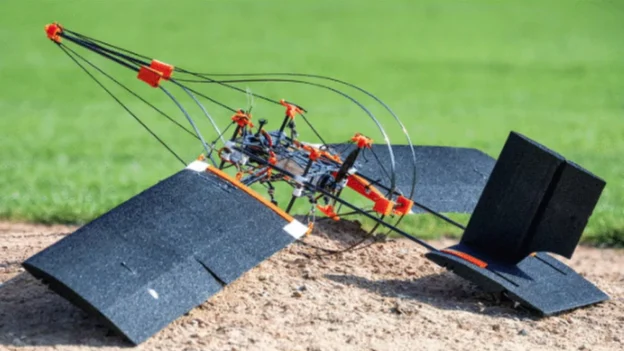The new SWIFT drone, developed by the Ecole Polytechnique Fédérale de Lausanne(EPFL), was inspired by the unique skull architecture of the woodpecker, a prototype with the capabilities to withstand and resist impacts that would normally render other similar flying devices useless.
The SWIFT drone structure is based on tensegrity.
The focus of the design is on replicating the biomechanics of the bird’s head, which has evolved to withstand repeated blows without brain damage. In SWIFT, this functionality translates into a tensegrity structure: an integration of carbon fiber rods, bungee cords and shock-absorbing plates to absorb the energy of a collision.
The fuselage protects critical components such as the engine and electronics by means of a system suspended with rubber cables. This assembly allows the internal elements to move up to 22 centimeters upon impact, dissipating the energy without transferring it directly.
This design is directly inspired by the structure of the woodpecker skull, which includes a rigid beak, a flexible hyoid bone and a layer of cancellous bone. In addition, the elements were reinterpreted with modern materials: carbon rods, flexible strips and plastic supports that work together to reinforce structural integrity.
On the other hand, the wings achieve high impact absorption. They are connected to the fuselage by a network of elastic cables and rods, inspired by the connective tissue that stabilizes the joints of birds.
Tests conducted by the team led by researcher Omar Aloui showed that SWIFT reduces impact forces by up to 70% compared to current drones of the same size and weight. The evaluations included controlled indoor collisions and flights in real outdoor conditions.
The drone model is emerging as a viable solution for applications in environments with a high density of obstacles, such as industrial inspectionsoperation in urban areas or reconnaissance activities in confined spaces.
The research published in Advanced Robotics Research demonstrates that incorporating solutions taken from nature is not only feasible, but effective in solving critical problems in technology. In this case, the challenge of building safer drones was addressed with an interdisciplinary approach that combines biology, structural engineering and advanced materials.
The tensegrity level of the EPFL woodpecker drone. Source: EPFLLIS
Source and photo: EPFL



